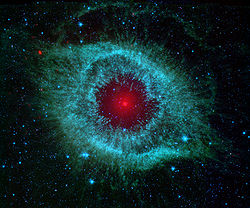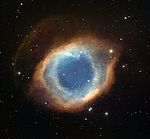- Helix Nebula
-
"Eye of God" redirects here. For other uses, see Eye of God (disambiguation).
Helix Nebula 
Infrared image of the Helix Nebula, taken by the Spitzer space telescope, 2007[1]
Credit: NASA, JPL, and K. Su (University of Arizona)Observation data
(Epoch J2000)Right ascension 22h 29m 38.55s[2] Declination -20° 50′ 13.6″[2] Distance 695+98
−52 ly (213+30
−16 pc)[3][4][5][a]Apparent magnitude (V) +7.6[2] Apparent dimensions (V) 25′[6] Constellation Aquarius Physical characteristics Radius 2.87 ly (0.88 pc)[6] Absolute magnitude (V) 6.58[b] Notable features One of nearest PNs Other designations NGC 7293[2] Caldwell 63[7] See also: Planetary nebula, Lists of nebulae The Helix Nebula (also known as The Helix, NGC 7293, or Caldwell 63) is a large planetary nebula (PN) located in the constellation Aquarius. Discovered by Karl Ludwig Harding, probably before 1824, this object is one of the closest to the Earth of all the bright planetary nebulae.[8] The estimated distance is about 215 parsecs or 700 light-years. It is similar in appearance to the Ring Nebula, whose size, age, and physical characteristics are similar to the Dumbbell Nebula, varying only in its relative proximity and the appearance from the equatorial viewing angle.[3] The Helix has often been referred to as the Eye of God on the Internet, since about 2003.[9]
Contents
General information
The Helix Nebula is an example of a planetary nebula, or 'planetary' formed at the end of a star's evolution. Gases from the star in the surrounding space appear, from our vantage point, as if we are looking down a helix structure. The remnant central stellar core, known as a planetary nebula nucleus or PNN, is destined to become a white dwarf star. The observed glow of the central star is so energetic that it causes the previously expelled gases to brightly fluoresce.
The Helix Nebula in the constellation of Aquarius lies about 700 light-years away, spanning about 0.8 parsec or 2.5 light-years. Recent images by the Hubble Space Telescope of the Helix Nebula are a composite of newly released images from the ACS instrument and the wide-angle images from the Mosaic Camera on the WIYN 0.9-metre telescope at Kitt Peak National Observatory.
Currently, the age is estimated to be 10,600+2,300
−1,200 years, based solely upon a measured expansion rate of 31 km·s−1.[3]Structure
The Helix Nebula is thought to be shaped like a prolate spheroid with strong density concentrations toward the filled disk along the equatorial plane, whose major axis is inclined about 21° to 37° from our vantage point. The size of the inner disk is 8×19 arcmin in diameter (0.52 pc); the outer torus is 12×22 arcmin in diameter (0.77 pc); and the outer-most ring is about 25 arcmin in diameter (1.76 pc). We see the outer-most ring as flattened on one side due to its colliding with the ambient interstellar medium.
Expansion of the whole planetary nebula structure is estimated to have occurred in the last 6,560 years, and 12,100 years for the inner disk[citation needed]. Spectroscopically, the outer ring's expansion rate is 40 km·s−1, and about 32 km·s−1 for the inner disk.
Knots
The Helix Nebula was the first planetary nebula discovered to contain knots. Its main ring contains knots of nebulosity, which have now been detected in many nearby planetaries. These knots are highly radially symmetric (from the PNN) and are described as "cometary", each containing bright cusps (local photoionization fronts) and tails. All extend away from the PNN in a radial direction. Excluding the tails, they are (very approximately) the size of the Solar system, while each of the cusp knots are optically thick due to Lyc photons from the (PNN).[3][6][10] There are more than 20,000 cometary knots estimated to be in the Helix Nebula.[5]
The excitation temperature varies across the Helix nebula.[5] The rotational-vibrational temperature ranges from 1800 K in a cometary knot located in the inner region of the nebula are about 2.5′ (arcmin) from the central PNN, calculated at about 900 K in the outer region at the distance of 5.6′.[5]
See also
- New General Catalogue (NGC)
Notes
Footnotes
Citations
- ^ Su, K. Y. L.; Chu, Y.-H.; Rieke, G. H.; Huggins, P. J.; Gruendl, R.; Napiwotzki, R.; Rauch, T.; Latter, W. B.; Volk, K. (March 2007). "A Debris Disk around the Central Star of the Helix Nebula?". The Astrophysical Journal 657 (2): L41-L45. arXiv:astro-ph/0702296. Bibcode 2007ApJ...657L..41S. doi:10.1086/513018.
- ^ a b c d "SIMBAD Astronomical Database". Results for Helix Nebula. http://simbad.u-strasbg.fr/Simbad. Retrieved 2006-12-07.
- ^ a b c d e O'Dell, C. R.; Balick, B.; Hajian, A. R.; Henney, W. J.; Burkert, A. (2002). "Knots in Nearby Planetary Nebulae". The Astronomical Journal 123 (6): 3329–3347. Bibcode 2002AJ....123.3329O. doi:10.1086/340726.
- ^ a b Harris, Hugh C.; Dahn, Conard C.; Canzian, Blaise; Guetter, Harry H.; Leggett, S. K.; Levine, Stephen E.; Luginbuhl, Christian B.; Monet, Alice K. B.; Monet, David G.; Pier, Jeffrey R.; Stone, Ronald C.; Tilleman, Trudy; Vrba, Frederick J.; Walker, Richard L. (February 2007). "Trigonometric Parallaxes of Central Stars of Planetary Nebulae". The Astronomical Journal 133 (2): 631–638. arXiv:astro-ph/0611543. Bibcode 2007AJ....133..631H. doi:10.1086/510348.
- ^ a b c d Matsuura, M.; Speck, A. K.; Smith, M. D.; Zijlstra, A. A.; Viti, S.; Lowe, K. T. E.; Redman, M.; Wareing, C. J.; Lagadec, E. (December 2007). "VLT/near-infrared integral field spectrometer observations of molecular hydrogen lines in the knots of the planetary nebula NGC 7293 (the Helix Nebula)". Monthly Notices of the Royal Astronomical Society 382 (4): 1447–1459. Bibcode 2007MNRAS.382.1447M. doi:10.1111/j.1365-2966.2007.12496.x.
- ^ a b c O'Dell, C. R.; McCullough, Peter R.; Meixner, Margaret (2004). "Unraveling the Helix Nebula: Its Structure and Knots". The Astronomical Journal 128 (5): 2339–2356. arXiv:astro-ph/0407556. Bibcode 2004AJ....128.2339O. doi:10.1086/424621.
- ^ O'Meara, Stephen James (2002). The Caldwell Objects. Cambridge University Press. ISBN 0-521-82796-5.
- ^ Hora, Joseph L.; Latter, William B.; Smith, Howard A.; Marengo, Massimo (2006). "Infrared Observations of the Helix Planetary Nebula". The Astrophysical Journal 652 (1): 426–441. arXiv:astro-ph/0607541. Bibcode 2006ApJ...652..426H. doi:10.1086/507944.
- ^ "Urban Legends Reference Pages". The Eye of God. http://www.snopes.com/photos/space/eyeofgod.asp. Retrieved 2007-07-16.
- ^ O'dell, C. R.; Balick, B.; Hajian, A. R.; Henney, W. J.; Burkert, A. (2003). "Knots in Planetary Nebulae". Winds, Bubbles, and Explosions: a conference to honor John Dyson, Pátzcuaro, Michoacán, México, September 9–13, 2002 (Eds. S. J. Arthur & W. J. Henney) Revista Mexicana de Astronomía y Astrofísica (Serie de Conferencias) (http://www.astroscu.unam.mx/~rmaa/) 15: 29–33. Bibcode 2003RMxAC..15...29O.
External links
- NASA APOD – May 10, 2003 NGC 7293: The Helix Nebula
- SEDS: NGC 7293, the Helix Nebula
- NightSkyInfo.com – NGC 7293, the Helix Nebula
- Snopes.com; Helix Eye of God Urban Legend
- The Helix Nebula on WikiSky: DSS2, SDSS, GALEX, IRAS, Hydrogen α, X-Ray, Astrophoto, Sky Map, Articles and images
Coordinates:
 22h 29m 38.55s, −20° 50′ 13.6″
22h 29m 38.55s, −20° 50′ 13.6″The Caldwell catalogue List C1 · C2 · C3 · C4 · C5 · C6 · C7 · C8 · C9 · C10 · C11 · C12 · C13 · C14 · C15 · C16 · C17 · C18 · C19 · C20 · C21 · C22 · C23 · C24 · C25 · C26 · C27 · C28 · C29 · C30 · C31 · C32 · C33 · C34 · C35 · C36 · C37 · C38 · C39 · C40 · C41 · C42 · C43 · C44 · C45 · C46 · C47 · C48 · C49 · C50 · C51 · C52 · C53 · C54 · C55 · C56 · C57 · C58 · C59 · C60 · C61 · C62 · C63 · C64 · C65 · C66 · C67 · C68 · C69 · C70 · C71 · C72 · C73 · C74 · C75 · C76 · C77 · C78 · C79 · C80 · C81 · C82 · C83 · C84 · C85 · C86 · C87 · C88 · C89 · C90 · C91 · C92 · C93 · C94 · C95 · C96 · C97 · C98 · C99 · C100 · C101 · C102 · C103 · C104 · C105 · C106 · C107 · C108 · C109See also Categories:- Aquarius constellation
- Caldwell objects
- NGC objects
- Planetary nebulae
Wikimedia Foundation. 2010.

